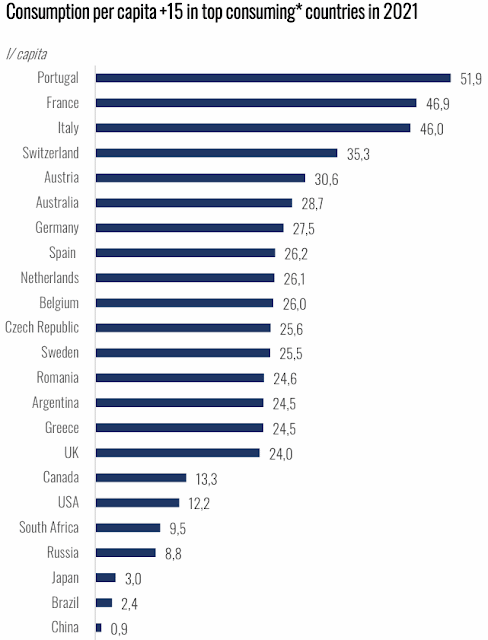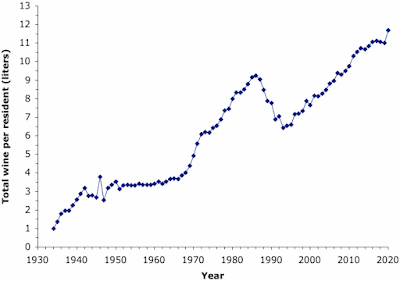The Gallup Poll has been quantifying the usage of alcohol in the USA for more than 8 decades, and this usage has remained relatively steady over the years. Since 1939, the average percentage of Americans who have said they are drinkers is 63%, quite close to Gallup's most recent reading of 67% (Americans and the future of cigarettes, marijuana, alcohol). Apparently, about 45% of Americans have had an alcoholic drink within the past week, while another 23% say they use it occasionally (the remainder are “total abstainers”).
However, alcohol consumption is usually divided into three categories: beer, wine, and spirits; and the most popular of these is not necessarily wine. So, let’s look at some of the data about this.
We should start, of course, by looking at current wine consumption, which we can do using: International Organisation of Vine and Wine (2022) State of the world: Vine and wine sector. This first graph shows those countries with 2021 wine consumption greater than 2 million hecto-liters (mhl). It looks good, with the USA way out in front. (Note: world wine production in 2021 was 250 mhl.)
However, the USA is also one of the most populous countries (with 330 million persons), so maybe this consumption is not surprising. What we really need to see is the consumption per person, which is shown in the next graph. Here, the USA drops a long way down the list, way behind culturally similar places like the United Kingdom and Australia, but behind even Sweden, and a bit behind Canada.
The importance of a comparison with similar cultures should be obvious. Comparing France to Italy and Spain makes sense, when it comes to wine consumption, but comparing these countries to the USA makes no sense. So, what is interesting in the data is that the USA is way behind most of the ostensibly similar cultures — wine is not all that popular in the USA, compared to elsewhere. Mind you, the largest collection of wine media in the world live there, and beg to differ in print, every week.
This leads us to ask about the trend through time. I have actually presented the data already for yearly wine consumption per capita in the USA, going back as far as the end of Prohibition (see: Per capita US wine consumption, by state). The next graph shows average wine consumption in liters per person (vertically) for every year (horizontally).
While the trend is basically upwards through time, towards more consumption per person, there are a number of interesting features. For example, note the sudden increase in 1946, the year after World War II ended, and the sudden increase in 2020, the first year of the current pandemic. There is also the serious long-term downturn in the mid 1980s to mid 1990s. No-one should conclude that wine is in any way a staple product in the lives of US citizens.
You could also compare this pattern to the similar graph for Australia (since 1950), as shown in my post on: How did Australian beer slobs become wine drinkers, which is somewhat similar — this is all very well. However, these two graphs differ completely from the one shown in my post on: Global wine consumption has been declining for a long time, which shows a continuous downward trend in wine consumed per capita, since the end of World War II. *
Clearly, this global decline has occurred in the Old World not the New World — cheap daily plonk is no longer as popular in Europe as it once was. I have discussed this point before, with reference to the graph in: The rise of the USA as the world's biggest wine consumer. The New World increase has not yet made up for this Old World decline. Wine needs to become even more popular in the USA, before that can happen.
It has been noted that wine has usually been associated in the USA with a particular type of group — one that is affluent, older, mostly male, and mostly white (What it’s really like to be a wine influencer). Now, however, we apparently have this news: Boomer wine buying faces big percentage decline. So, this wine-consuming group is on the way out, which does not portend well for US wine consumption.
There are other effects on the popularity of wine buying, of course. For example, there are fads (From Lizzo To ‘Sideways’: How pop culture kills, and spikes, wine sales). Even worse, the Vast majority in the US have a negative view of alcohol consumption; so, we will see what we see about the future.
In next week’s post, we will look at the comparison with beer and spirits consumption.
* There are many possible reasons for the decline of Old World wine drinking, including changes in purchasing power of salaries. However, one that you may not know about is that in 1956 France finally banned wine in school canteens for those under 14 years of age (1956, when France prohibited serving wine for lunch in school cafeterias), and banned it for all school children in 1981.





No comments:
Post a Comment